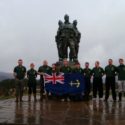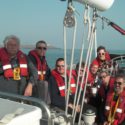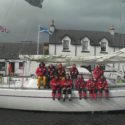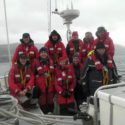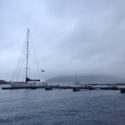Picture the scene. It is the middle of the night, and, just off the southwest coast of Scotland, a lone yacht is struggling through the waves. The wind is a steady Beaufort Force 7; in the United States, that is when the Coastguard issues a small craft warning; in Canada it is merely described as Strong. Over here, in the UK, however, we call it a Near Gale. The yacht in question was HMSTC Endeavour, based in Gosport, and, at that point in time, I was in my cabin, trying to get some sleep.
Aged 14, and with less than three months since I had joined the CCF, I applied to join a CCF RN/RM expedition to deliver Endeavour, a 67 ft, steel hulled Challenger 67 yacht from Gosport to Inverness, for her then to be taken on to Stavanger, on the south coast of Norway, by a RM Corps Team. She would then be sailed down to Gibraltar by another group of Marines, who are skiing, sailing, cycling, kayaking and running 6656 km in an exercise dubbed the 1664 Challenge. This Challenge is aiming to help raise money for the Royal Marine charities, as part of the RM 350 celebrations.
As I thought that every Cadet in the country would want a chance to sail in excess of 800 nautical miles, it was a great surprise when I found out that I had been selected. After participating in the compulsory Sea Survival training at Gosport between Friday 17th and Sunday 19th of January, I arrived at HMS Hornet full of anticipation on the 7th of March. I needn’t have worried. The crew, compromising of the Skipper, Paul Molyneaux, the Mate, Peter Weeks, and seven other CFAVs, made me feel at home almost immediately. For a 15 year old of only a day, I couldn’t have asked for a better bunch of crew members. Even though I was the only cadet on board, and thus I had no one remotely near my age group, I was still made to feel part of the crew from the word ‘go’.
It was under clear, blue skies that we left Portsmouth on the 8th of March, and the clouds didn’t return until after we had left Dublin. An overnight sail to Falmouth was our introductory passage, followed by the 36 hour leg towards Dublin. Out in St George’s Channel, at about 0200, one of the best moments of the trip occurred. For half an hour, in the middle of the night, we had a pod of dolphins follow us. As a morale booster, halfway through the 0000-0400 watch, there could have been nothing better.
Having spent a day sightseeing in Dublin, we then set off for Douglas, on the Isle of Man. This leg, taking less than a day, was pretty uneventful, and we had a flat calm all the way. However, it did contain one of the most challenging (at least, for me) moments of the entire trip. I was at the helm as we took Endeavour into Douglas harbour in thick fog. Take it from me; navigating by a temperamental lighthouse is not easy.
We only spent 18 hours in Douglas, and so we set off at lunchtime the next day. With a fair wind, and clear skies, I thought the sailing until we got to Oban would be pleasant. That night, with a Force 7 in our face and a seven knot tide against us, making the boat average 1.5 knots over ground, I was proven wrong. There is a lighthouse on the Mull of Galloway that the Blue and Green Watches never want to see again.
When I woke up the next morning having attempted to have a good night’s sleep, we really hadn’t gone far overnight. However, by the time I had come off Mother Watch that afternoon, the tide had turned and we had both the tide and the wind with us. Doing 15 knots over the ground doesn’t happen very often in a Challenger 67. After quite a nice, if not wet (we were by now in Scottish waters) sail, along with a hurried sail drop near Corryvreckan (the second largest whirlpool in the world), we arrived in Oban. The Gateway to the Islands made a pleasant change from a rolling and pitching boat, even if I did initially wonder why the ground wasn’t slanted at a 20 degree heel and why I wasn’t constantly getting bombarded by spray.
The next day we left Oban for a very short sail five miles up the coast to Dunstaffnage. The weather was Scottish, to say the least, but this emphasized the bleak and majestic scenery around us. Having spent the night in a marina with brilliant showers, we left early the next morning for Fort William, and the Caledonian Canal.
Scotland is beautiful. And, living there, I would say that it is at its best in the sun. Unfortunately, we didn’t have any. Through the Caledonian Canal, the weather was interesting at best (45 knot gusts on Loch Ness are interesting, aren’t they?). Having posed for a photo at the Commando Memorial at Spean Bridge in our polo shirts (it was March, what were we thinking?), we decided that full heavy weather gear was the way forward from then on. At long last, we arrived in Inverness, where, for a few blessed seconds, the sun did come out. Finally, it was down to the menial task of cleaning the boat for the next crew to take her on to Stavanger. I was on that crew, but, as they say, that’s another story.
I would like to thank, amongst others, the SO2 Cadet Activities: Claire Moore, my Contingent Commander: Lieutenant Colonel Streatfeild-James, the Skipper: Paul Molyneaux, the Mate: Peter Weeks and, of course, the entire crew, for helping make this a trip of a lifetime. I doubt I will ever forget it!
Cdt Angus Lapslie

